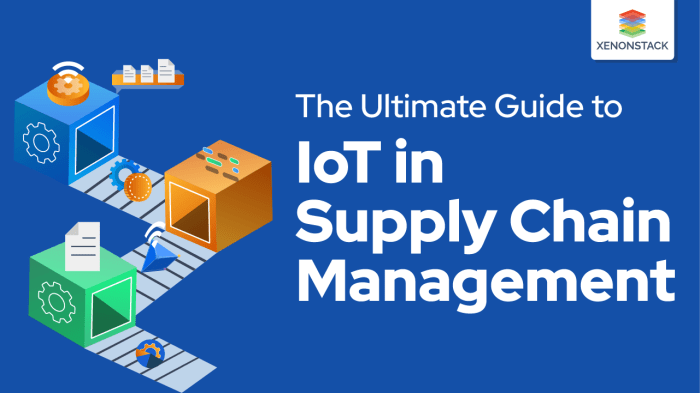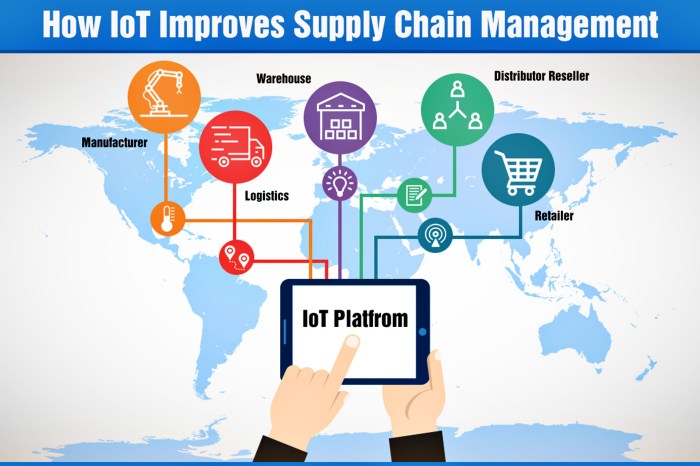Optimizing the Supply Chain with ERP and IoT Technology represents a significant leap forward in efficiency and responsiveness. In today’s dynamic global marketplace, businesses face unprecedented pressure to streamline operations, enhance visibility, and improve decision-making across their entire supply chain. The integration of Enterprise Resource Planning (ERP) systems and the Internet of Things (IoT) offers a powerful solution, promising enhanced agility, reduced costs, and improved customer satisfaction.
This exploration delves into the synergistic potential of these technologies, showcasing their individual contributions and the transformative impact of their combined power.
This discussion will cover the core functionalities of ERP systems in supply chain management, demonstrating how they improve inventory management, procurement, and production planning. Furthermore, we will examine the role of IoT sensors in providing real-time visibility into every stage of the supply chain, from raw material sourcing to final product delivery. We will then analyze how the integration of data from these two powerful sources leads to improved forecasting, reduced lead times, and ultimately, a more optimized and resilient supply chain.
Real-world examples and future trends will be explored to provide a comprehensive overview of this transformative technology.
Supply Chain Optimization: Leveraging ERP and IoT Technologies
Supply chain optimization is the process of improving the efficiency and effectiveness of all activities involved in moving goods and services from origin to consumption. This encompasses everything from sourcing raw materials and manufacturing to distribution, warehousing, and customer delivery. In today’s dynamic global market, optimizing the supply chain is crucial for businesses to remain competitive, agile, and profitable.
Modern supply chains face numerous challenges, including increasing complexity, unpredictable demand fluctuations, geopolitical instability, and the need for enhanced sustainability.
Integrating Enterprise Resource Planning (ERP) and Internet of Things (IoT) technologies offers a powerful solution to these challenges. ERP systems provide a centralized platform for managing various aspects of the supply chain, while IoT devices enhance real-time visibility and data-driven decision-making. The combined power of these technologies enables businesses to achieve greater efficiency, reduce costs, improve responsiveness, and enhance customer satisfaction.
Enterprise Resource Planning (ERP) Systems in Supply Chain Management, Optimizing the Supply Chain with ERP and IoT Technology

ERP systems act as a central nervous system for a business, integrating data and processes across various departments, including procurement, production, inventory management, sales, and finance. This integration streamlines operations, improves data accuracy, and reduces redundancies. In supply chain management, ERP systems play a vital role in optimizing inventory levels, improving procurement processes, and facilitating efficient production planning.
For example, ERP systems can automate the process of ordering raw materials based on real-time demand forecasts, preventing stockouts and minimizing storage costs. They also facilitate efficient production scheduling by optimizing resource allocation and minimizing downtime. Furthermore, ERP systems provide real-time visibility into inventory levels, enabling businesses to make informed decisions about production and distribution.
Consider a hypothetical scenario where a manufacturing company experiences frequent stockouts of critical components, leading to production delays and lost sales. Implementing an ERP system allows for better demand forecasting and automated procurement processes. This results in improved inventory management and more efficient production planning. The following table illustrates the impact:
| KPI | Before ERP | After ERP | Percentage Change |
|---|---|---|---|
| Inventory Turnover | 2.5 | 4.0 | +60% |
| Stockout Rate | 15% | 5% | -66.7% |
| Production Lead Time | 14 days | 10 days | -28.6% |
| On-Time Delivery Rate | 80% | 95% | +18.8% |
Internet of Things (IoT) and its Application in Supply Chain Visibility
IoT technology, with its network of interconnected devices and sensors, provides unprecedented real-time visibility into the supply chain. This visibility allows businesses to monitor goods and assets throughout their journey, from origin to destination. Data collected by IoT sensors provides insights into various aspects of the supply chain, enabling proactive management and improved decision-making.
- Temperature Sensors: Monitor the temperature of perishable goods during transportation and storage, ensuring product quality and preventing spoilage.
- Location Sensors (GPS): Track the location of shipments in real-time, providing visibility into transit times and potential delays.
- Pressure Sensors: Monitor pressure levels in containers or pipelines, preventing damage to goods and ensuring safety.
- Humidity Sensors: Monitor humidity levels, crucial for maintaining the quality of sensitive goods.
- Vibration Sensors: Detect vibrations that could indicate potential damage to goods during transportation.
While IoT data offers significant advantages for predictive maintenance and risk mitigation, it also presents limitations. Data security and the volume of data generated require robust infrastructure and analytical capabilities. Accurate interpretation of data and effective integration with existing systems are also crucial for realizing the full benefits of IoT technology.
Integrating ERP and IoT for Enhanced Decision-Making
The integration of IoT data with ERP systems creates a powerful synergy, providing a holistic view of the supply chain. Data from IoT sensors, after processing and analysis, feeds into the ERP system, enriching the information available for decision-making. This integration improves forecasting accuracy, reduces lead times, and enhances overall supply chain efficiency.
For example, real-time data on inventory levels, coupled with demand forecasts generated from IoT-enabled sales data, can optimize production schedules and prevent stockouts. The following flowchart illustrates the data flow:
Flowchart: IoT devices collect data (e.g., location, temperature, condition) -> Data transmitted to a cloud-based data analytics platform -> Data processed and analyzed (e.g., predictive analytics, anomaly detection) -> Processed data integrated with the ERP system -> ERP system updates inventory levels, forecasts demand, and optimizes production schedules.
Different data integration strategies exist, including real-time integration, batch processing, and message queuing. The choice of strategy depends on factors such as the volume of data, the required level of real-time visibility, and the technical capabilities of the ERP and IoT systems.
Case Studies: Real-World Examples of Successful Integration

Many companies across various industries have successfully integrated ERP and IoT technologies to optimize their supply chains. In the manufacturing sector, for instance, a large automotive parts supplier implemented an IoT-enabled system to monitor the condition of its machinery. This provided real-time insights into potential equipment failures, allowing for proactive maintenance and minimizing downtime. The integration with their ERP system enabled them to optimize production schedules based on real-time machine status and availability.
This resulted in significant improvements in production efficiency and reduced maintenance costs.
Key learnings from such implementations include the importance of careful planning, robust data security measures, and effective change management. Challenges encountered often include data integration complexities, the need for skilled personnel, and the initial investment required. Overcoming these challenges often involves phased implementation, strong stakeholder collaboration, and a focus on continuous improvement.
Future Trends and Considerations
Emerging technologies like Artificial Intelligence (AI) and blockchain are poised to further revolutionize supply chain optimization. AI-powered predictive analytics can enhance forecasting accuracy and optimize logistics routes. Blockchain technology can improve transparency and traceability throughout the supply chain, enhancing security and accountability.
However, the increasing reliance on IoT devices also raises concerns about data security and privacy. Robust cybersecurity measures, including data encryption, access controls, and regular security audits, are crucial for protecting sensitive supply chain data from unauthorized access and cyberattacks. Compliance with relevant data privacy regulations is also paramount.
The convergence of ERP and IoT technologies offers a compelling pathway towards a truly optimized supply chain. By harnessing the power of real-time data and integrated systems, businesses can achieve unprecedented levels of efficiency, transparency, and responsiveness. While challenges related to data security and integration exist, the potential benefits—including reduced costs, improved forecasting, and enhanced customer satisfaction—far outweigh the risks.
As technology continues to evolve, the integration of artificial intelligence and blockchain will further refine supply chain optimization, paving the way for a more agile, resilient, and profitable future. Embracing these technologies is not merely an option; it is a strategic imperative for businesses seeking to thrive in today’s competitive landscape.
FAQ Guide: Optimizing The Supply Chain With ERP And IoT Technology
What are the major security risks associated with IoT in supply chain management?
Major security risks include data breaches, unauthorized access to sensitive information, and potential disruption of operations through cyberattacks targeting IoT devices. Robust cybersecurity measures are crucial.
How can companies ensure a smooth integration of ERP and IoT systems?
Successful integration requires careful planning, selection of compatible systems, robust data integration strategies, and a phased implementation approach. Collaboration between IT, supply chain, and business stakeholders is essential.
What is the return on investment (ROI) for implementing ERP and IoT in supply chain optimization?
ROI varies depending on factors such as company size, industry, and specific implementation. However, potential benefits include reduced inventory costs, improved efficiency, reduced lead times, and increased revenue, leading to a significant positive ROI over time.
What are some common challenges faced during the implementation of ERP and IoT systems?
Common challenges include data integration complexities, resistance to change within the organization, high initial investment costs, and the need for skilled personnel to manage and maintain the systems.
READ MORE :
- https://rmm.abyadi.com/how-erp-internet-of-things-supports-predictive-maintenance-in-heavy-industries/
- https://rmm.abyadi.com/how-iot-transforms-erp-systems-into-more-proactive-and-real-time-solutions/